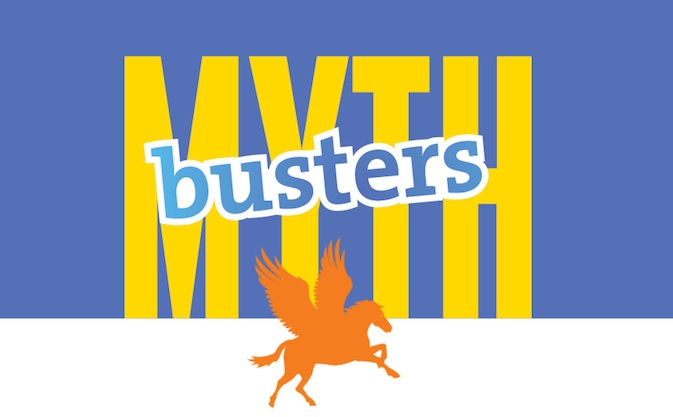Have you heard the latest rumour? Misconceptions about early childhood education and care practice are rife in our sector. Rattler talks to experts and educators to debunk the myths and paint a clearer picture.
(This article first appeared in Rattler 108, published by Community Child Care Co-operative (NSW). To purchase a copy, go to: www.ccccnsw.org.au/shop)
Myth 1: Programs must conform to exact guidelines to be acceptable.
NSW Department of Education and Communities (Early Education and Care Directorate):
‘The education and care services national law and regulations set out three basic requirements for the educational program. First, the program must be based on, and delivered in a way that is consistent with, the approved learning frameworks, taking into account the needs, interests and experiences of each child. Second, the service must document information about each child’s participation in the program as well as documenting an assessment of their learning and progress towards five learning outcomes in a way that can be shared with the child’s family. Third, information about the content of the program and the way in which it is delivered must be displayed at the service, or, in the case of family day care, in each educator’s home.
No two services are exactly the same; the type of service, its size, location, its families, children and local community are different and educators in each service have a range of different skills and experience. In recognition of this, the Regulations do not prescribe any particular way in which the program should be documented or displayed. While it may be helpful to seek ideas and inspiration from other services, educators are encouraged to explore ways to document the program that suits their setting, their families and their educators. This might include a visual record on the wall or a board, a journal or daily diary in each room or a digital record that can also be emailed to families who do not attend the service regularly.
Similarly, the Regulations do not prescribe how, or how often, educators must document children’s learning. Whatever method is used, information about each child’s progress towards the learning outcomes must be included. Most educators use a range of ways to capture significant moments in each child’s learning, including observations, jottings, diary entries, annotated photographs, learning stories and samples of children’s work. It is important that whatever method is used, educators’ valuable time is not wasted on recording things that are have little value for educators, families or children. Quality, not quantity is a good rule of thumb.’
 Kay Turner, SDN executive director, Integrated Services and Organisational Development:
Kay Turner, SDN executive director, Integrated Services and Organisational Development:
‘I’ve enjoyed seeing our staff come together to interpret the components of the NQF and to discuss how to apply them to the different SDN contexts. With services in different parts of NSW and the ACT we’re glad we don’t have to conform to exact guidelines to be acceptable! Each part of the Framework has a different role and requires a different response from us as providers. As a whole the Framework focuses on outcomes for children, rather than providing a prescriptive method for us to use.
Some things in the National Law and Regulations are precise and tell us exactly what to do, for example, educator-to-child ratios and qualification requirements, and the prescribed information to be displayed in a service. However, others aren’t so precise and require us to use our professional judgement based on the outcomes to be achieved. For example, the regulation relating to fence height doesn’t tell us exactly how high a fence should be. We’re expected to make a judgement focused on the safety outcome for the children.
The NQS and the Learning Frameworks outline the indicators of quality to be seen and experienced in our service, allowing our educators to develop a service and a curriculum that is relevant for each context and that is responsive to the diversity of children and families in the communities where we operate.
The Standard requires us to demonstrate each element. It doesn’t prescribe exactly how the standard must be demonstrated. It definitely doesn’t prescribe what an educator has to do every day! At SDN, we’ve been able to have our Inclusive Education and Care Practice Unit team, our Service Delivery Accountability Unit Team, our community leaders and our educators working together in teams to develop the pathways we will take to not only be compliant with the National Law and Regulations but to ensure we’re building a culture of quality outcomes for children and families, of continuous improvement and of programs that are responsive to children and families. This has helped us to be given ratings of Exceeding the National Quality Standard.
The National Quality Framework is not just about compliance with rules. It’s designed to support continuous improvement and quality, including children’s safety and wellbeing, to support professional judgement and innovative, responsive, contextual and relevant services with a focus on great outcomes for children.’
Myth 2: You don’t need knowledge of child development these days.
Sandra Cheeseman, lecturer Institute Early Childhood, Macquarie University:
‘To be a great educator you need a great deal of knowledge. I imagine this myth stems from a misunderstanding from those encouraging educators to look beyond only child development theory as one way to understand and interpret children’s learning and behaviour.
Traditional early childhood teacher and educator courses focused primarily on the developmental theories of Piaget. His stages of cognitive development are useful in showing how children progress in the complexity of their learning and have assisted educators to plan effectively and use play as a means to support children’s learning.
More recently though, a number of other theoretical frames have emerged that help us to see other influences important to children’s learning. The EYLF encourages educators to draw on multiple theoretical perspectives and not feel confined to only developmental theories. The socio-cultural theories talk about the importance of the people in young children’s lives and the things in the environment that children can observe and play with. These theories acknowledge that children can learn very different things at different times in their life according to what they are exposed to.
They have also helped us to see children as more capable and resourceful than the developmental theories might recognise. The behaviourist theories help us to understand how learning can be supported by encouragement and can guide educators to think about how their responses and actions can influence children’s learning.
Drawing on aspects of all of these theoretical perspectives helps us to provide rich, meaningful and socially just learning experiences and assists us to listen and respond to children as they contribute to their own learning experience. The essence of following children’s interests and creating an environment for an engaging emergent approach to curriculum hinges on a good understanding of these multiple theoretical perspectives.
It is not a case of simply waiting for children to have a good idea and playing along. To be an inspirational early childhood educator we need to be thinking deeply about what we see in children’s play and how we can extend the experience so learning becomes rich and exciting. To do this well we need lots of knowledge about children and the way they learn and develop.’
 Liam McNicholas, ACT manager for Goodstart Early Learning and a freelance writer on early childhood education:
Liam McNicholas, ACT manager for Goodstart Early Learning and a freelance writer on early childhood education:
‘It seems one of the things educators have most struggled with in the Early Years Learning Framework is a lack of specific direction. The EYLF is designed as a guide, not a rigid template. It draws on a range of views and perspectives, but does not say: “this is how to do it”. When I first started in early learning over 10 years ago, I used to check off children’s abilities against a developmental checklist. This way of working was common in the sector at the time, and on first glance it appeared that the EYLF was encouraging us to throw all our templates and checklists away!
One of the great things about the new Framework is it encourages us to work with children in a holistic way. As well as focusing on all the things a child is capable of, we should also critically reflect on our own skills and strengths as educators and teachers.
Co-constructing learning with children encourages us to view children as equal partners in the learning environment. Our work shouldn’t just be about helping children meet “milestones”, but about supporting each individual child to reach their potential and positively affect their world. Does this mean that we don’t need to know anything about child development? Absolutely not!
As with any profession, an educator has to have a strong knowledge of the fundamentals. Pilots have to understand the technical operation of an aeroplane before they can fly, so why shouldn’t educators know the background on children’s development and learning before they work with young children?
A strong knowledge of children’s development helps us to scaffold children’s learning, as well as giving us the tools to support specific children experiencing vulnerable situations. Decades of research on how children develop can provide us with frameworks and guides to support our work with children—it’s just important to always remember that it doesn’t tell us everything about a child.’
Myth 3: Programs must ensure children are not given opportunities for risk-taking activities
Luke Touhill, early childhood teacher and consultant:
‘One of the great things about the EYLF and the NQS is that both actually go out of their way to deliberately acknowledge the importance of risk and challenge for children’s learning. Don’t believe it? Have a look at Quality Standard 3.2 or the Learning Environments section of the EYLF—both deliberately highlight opportunities for risk-taking and challenge as valuable components of high quality early childhood settings.
Of course there is still an emphasis on safety and care—no one wants to see children needlessly hurt—but there is also a growing recognition that “risk-free” learning environments may actually be doing more harm than good. Children need opportunities to take risks and challenge themselves if they are to learn how to make such decisions wisely. Increasingly the research evidence backs this up. Children who have opportunities to take risks in their play are typically better at judging when a risk is worth taking and when it is best avoided.
As Macquarie University researchers Shirley Wyver and Helen Little (2008, p.39) note:
“Failure to provide children with stimulating and challenging experiences through which they can engage in positive risk-taking exposes them to different risks that compromise their health and development”.
None of this means that safety goes out of the window! As we embrace new approaches to risk and challenge we also need to remember our duty of care to protect the children with whom we work. Part of our professional responsibility is to balance safety with opportunities for reasonable and appropriate risk-taking. Such a balance is not always easy to achieve. But at least we now have a regulatory system that goes some way to recognising the importance of such decision-making as well as acknowledging our ability, as professionals, to make such decisions in the best interests of children and their wellbeing—both now and into the future.’
 Margaret Sims, professor of Early Childhood at the University of New England, NSW:
Margaret Sims, professor of Early Childhood at the University of New England, NSW:
‘As early childhood programs are pushed to include a greater focus on ‘academics’ and to manage the legal issues associated with safety, they are more and more likely to become ‘risk adverse’: that is to set up physical environments that reduce opportunities for risk-taking activities. While research clearly demonstrates rough and tumble play has an extremely important contribution to make to children’s development, such play opportunities tend to be restricted to the home environment, and not encouraged or supported in formal programs.
This limitation on physical play has led to the characterisation of today’s children as “the bubble-wrap generation”. This is unfortunate, as risky play is considered to have an important role in providing children with opportunities to practice managing physical and emotional challenges. Sandseter and Kennair (2011) argue that risky play evolved precisely because children needed opportunities to experiment with challenges for which they had natural and instinctual fears; challenges such as exploring what it feels like to be high up and how to manage heights without falling.
Risky play enables children to develop the physical skills to manage such risky situations, and, through their physical confidence, overcome the emotional fear associated with them. Without these experiences, they argue, children will not overcome emotional (instinctual) inhibitions, leading to an increased risk of “…neuroticism or psychopathology.” Through out the life course.
Early childhood programmes today are caught in the tension between what we know provides good learning for children (risky play environments) and the restrictions placed upon us by legal requirements for safe environments. Our challenge is to show the importance of risky environments for children and how we, as skilled educators, make these risky environments safe through our intentional teaching.’
Myth 4: Don’t set up experiences for children: they will ask for what they want.
Margaret Sims
‘There is considerable confusion between the philosophy of learning through play and the concept of intentional teaching. To many these look to be polar opposites. Learning through play is enshrined in early childhood philosophy and has been so for decades. Piaget’s early concept of “the little scientist” suggested the role of adults was to set up an interesting and challenging environment then stand back and allow children to explore as they wished.
This evolved into modern ideas of children as active agents in their learning with the role of adults being one of building on children’s interests. Thus arose the idea that adults should not set up experiences for children, as they will ask for what they would like to be provided with on the day.
However, modern early childhood philosophy couples the fundamental principle of learning through play, with that of intentional teaching. As defined in the Early Years Learning Framework (EYLF) intentional teaching is “deliberate, purposeful and thoughtful”. Intentional teaching is based on an in-depth understanding of children’s interests and strengths.
Educators who intentionally teach have a clear idea in their head of the learning opportunities they wish to offer children. They intentionally set up challenging and interesting experiences (including routines) based on their understanding of children’s interests and the learning opportunities they want to offer. They purposefully interact with children who chose to become engaged in these experiences to scaffold and extend thinking and participation. They thoughtfully reflect on children’s participation and learning and use their reflections to guide the new experiences (or new ways to participate in routines) they plan to offer next.
To the outsider, it looks as if children are totally in control: choosing what to do, with whom and when. To the skilled educator, planning, preparation and participation are demonstrated throughout the day in all experiences (routines and activities). Skilled educators set up experiences (and routines) because these have been carefully planned to attract children and to offer the right mixture of challenge, learning and success to children who are carefully scaffolded and supported.’
 Rebecca Boland, director Clarence Town Preschool, NSW
Rebecca Boland, director Clarence Town Preschool, NSW
‘Interestingly, this is a myth that I have actually been given as advice by a well-meaning person! The introduction of the emergent curriculum may, I feel, have contributed to this myth. Earliest conversations around this “new way” spoke of starting with a blank slate, forgetting about programming and ‘leaving it all to the children’. The underlying ideas of power and receptivity to children were well founded, however the message did not translate clearly and became one of myths and whispers.
Dynamic early childhood settings are rich with activity; they provide a stable base for children to return to and to build their skills while also providing inspiration, provocation and challenge. When children, educators and families work and plan together we can create a learning environment that is truly child-centred.
Our preschool program in action may appear quite busy to a visitor. We have several established learning areas that are rich with materials, loose parts and creative provocations. As children interact with each other and the environment, our educators observe, interact, and talk with the children to learn where they would like their play to grow.
Through these intentional actions we are able to work with children to build on our experiences and develop the environment. As our children return to preschool and continue with play from a previous session they are able to build on their skills, use their prior knowledge, develop their sense of self and extend their sustained thinking. Should a child be starting-over each time they came to preschool we would see a dramatic reduction in skill development, sustained involvement and each child’s sense of being, belonging and becoming.’



No Comments Yet